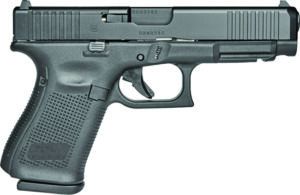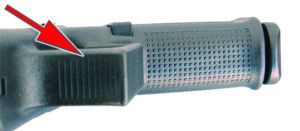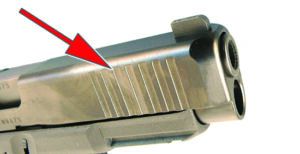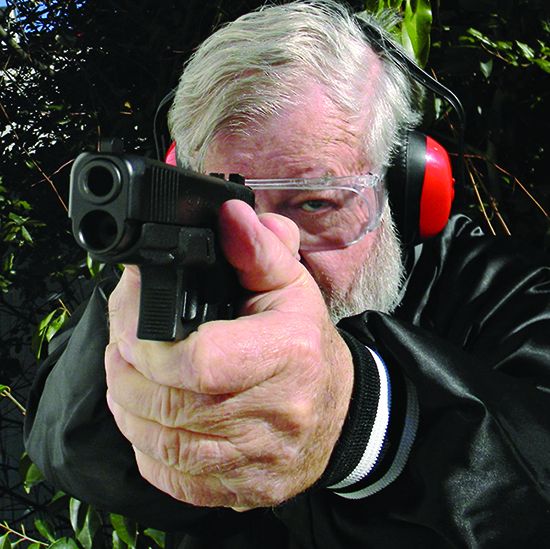Polymer-frame striker-fired handguns are flexible in design and performance, so it is simple enough to design a pistol with different-length slides and frames. In the past, full-size service guns were usually downsized by shortening the slide, and often the slide and the frame, creating a compact pistol. Among the most famous compact designs is the Glock 19 9mm, shrunk in size from the Glock 17. Later, Glock introduced the Glock 19X and the similar Glock 45 9mm. These pistols feature a Glock 19 compact slide and full-size Glock 17 frame. The pistol is fast from leather and features a full-length magazine. Some were skeptical, but the 19X pistol has been proven in hard use.
In this test, we have other variations, a long-slide short-polymer-frame design and a short-frame standard-slide combination. The Walther PDP Compact, or PDPC for short, is a compact-frame pistol with a 5-inch barrel and slide. The Glock 49 9mm is a Glock 19 compact frame with a Glock 17 service-pistol slide. These new pistols may be a good fit for many shooters with average to small hands in particular, including concealed-carry handgunners, practical competition shooters, and home defenders. Does the service-pistol slide and compact-frame-grip-type pistol pan out in action? And if so, which of the two, the Walther PDP Compact or the Glock 49, is the better choice? Our testers get to the bottom of the question.
Glock 49 MOS PA495S203MOS 9mm Luger
$620
Gun Tests grade: A
The Glock 49 is a good shooter and is reliable. In combat fire and recoil comfort, the Glock more than held its own. It will be a good addition to the Glock line and will be the best choice for many shooters.

| Action Type | Semi auto, Safe Action, striker fire, Gen 5 |
| Overall Length | 7.32 in. |
| Overall Height | 5.04 in. |
| Maximum Width | 1.3 in. |
| Weight Unloaded | 22.75 oz. |
| Weight Loaded | 27.75 oz. |
| Barrel | 4.5 in. |
| Slide | Black phosphate-finished steel |
| Slide Retraction Effort | 16.0 lbs. |
| Frame | Black polymer |
| Frame Front Strap Height | 2.0 in. |
| Frame Back Strap Height | 3.6 in. |
| Grips | Replaceable back straps |
| Grip Thickness Maximum | 1.3 in. |
| Grip Circumference Maximum | 6.0 in. |
| Front Sight | Post, white dot |
| Rear Sight | Fixed outline |
| Trigger Pull Weight | 5.6 lbs. |
| Trigger Span | 2.45 in. |
| Magazines | (3) 15 round |
| Safety | Trigger lever |
| Warranty | Limited lifetime |
| Telephone | (800) 955-4856 |
| Website | US.Glock.com |
| Made In | U.S. |
Eight of ten outlets asked exactly the same price for the newest Glock. A few scalpers were asking $717.89 for the piece. A local shop was dead on the money at $620, and we purchased the pistol from them. The Glock 49 is a lash up of the Glock 17 and Glock 19. The Glock 19X and Glock 45 9mm utilize the Glock 17 full-size frame and Glock 19 compact slide. The Glock 49 is another thing altogether, a Glock compact frame with a full-size slide.
The Model 49 features an optics-ready slide and forward cocking serrations, the new Glock Marksman barrel, and a slide with a nicely contoured muzzle end. The pistol is supplied with three 15-round magazines, optics plates, a gun lock, manual, and plastic cleaning rod in a locking case. Both guns are equal in those regards. The sights are equal to the Walther, but no better. The pistol’s grip treatment is well designed and offers good adhesion. The trigger breaks at 5.6 pounds and is as clean as any other Glock pistol. The grip panels are easily changed, if desired. We left both pistols as issued, as medium-sized hands seem fine with the default setting.

The pistol is slightly smaller in all dimensions than the Walther, an advantage in concealed carry. A rater with a great deal of police experience and cross-country driving as well noted that a full-sized slide may be concealed in an inside-the-waistband holster, while a large handle isn’t so easily concealed. Another advantage of these compact-grip pistols is that when driving, a larger grip digs into the back. To make matters worse, you may squirm around trying to get comfortable, and it makes for back strain. So, the short-grip long-slide pistol may be an advantage in that way. Also, the long sight radius is an aid in both quickly lining up on target and in reliability.
We fired the Glock with the same loads as the Walther, and the advantages of each pistol were clear. The Walther’s slide lock is larger and more easily manipulated. The Gen 5 ambidextrous slide lock of the Glock operates well, but it simply isn’t as fast as the Walther’s. Grip treatment is similar, but the Walther gets the nod. Sights are equal. The Walther trigger action is better, although this isn’t as apparent in speed shooting. Recoil was greater with the larger, heavier, and longer-barrel Walther. The Walther’s longer barrel produced a slight velocity advantage.
During the combat firing test, the Glock 49 produced good results. Combat groups were pretty much equal at 7 to 10 yards. At 15 yards, still pounding away, the Glock’s lower felt recoil resulted in smaller combat groups. The Walther also fired slightly higher, probably due to muzzle flip, at longer range. We fired a little more than anticipated to confirm this difference in the two handguns.

After firing the combat course and cleaning the guns, we considered a difference in takedown. Each field-strips simply enough. The Glock system, seen ages ago on Astra pistols, is simple enough. The Walther modifies this system to use levers that are pulled and lock in place as the pistol is disassembled. The spring-loaded Glock system isn’t any problem to use, but we like the Walther better. It is less likely to fumble. Cleaning and maintenance of both are simple. After cleaning the handguns and firing a fouling shot, we proceeded to fire the pistols for accuracy at 25 yards. The Glock suffered in target accuracy compared to the Walther’s slick trigger and longer sight radius. Still, the Glock is a good shooter and delivered decent results at 25 yards.
Left-hand compatibility is good with each pistol. There is no problem for our left-handed brothers and sisters to fire either — a marked change from earlier Glock that lacked an ambidextrous slide lock. We were able to hit the magazine release with our left forefinger without difficulty.
Our Team Said: Dimensionally, the Glock will have the advantage in concealed carry. There are limitless choices in holsters for a Glock 17 slide length, and the Walther PDP Compact is more difficult to holster. It was a close call, but after re-examining the shooting tests several times in conversation and in handling the pistols after the shooting, we narrowly favor the Walther PDP Compact.
| 9mm Luger Range Data | ||
| Federal Premium 147-grain HST JHP | Walther PDP Compact | Glock 49 MOS |
| Average Velocity | 1001 fps | 980 fps |
| Muzzle Energy | 327 ft.-lbs. | 313 ft.-lbs. |
| Small Group | 1.8 in. | 2. 0 in. |
| Average Group | 2.4 in. | 2.5 in. |
| Federal Premium 147-grain Syntech TSJ | Walther PDP Compact | Glock 49 MOS |
| Average Velocity | 955 fps | 947 fps |
| Muzzle Energy | 298 ft.-lbs. | 293 ft.-lbs. |
| Smallest Group | 2.0 in. | 2.45 in. |
| Average Group | 2.4 in. | 2.75 in. |
| Speer Gold Dot 124-grain GDHP | Walther PDP Compact | Glock 49 MOS |
| Average Velocity | 1121 fps | 1099 fps |
| Muzzle Energy | 346 ft.-lbs. | 333 ft.-lbs. |
| Smallest Group | 1.7 in. | 2.1 in. |
| Average Group | 2.2 in. | 2.6 in. |
We fired groups at 25 yards from a benchrest position using an MTM Case-Gard K-Zone Shooting Rest. We used a Competition Electronics Pro Chrony to measure muzzle velocities. Notes: JHP = jacketed hollow point. TSJ = Total Synthetic Jacket. GDHP = Gold Dot Hollow Point. HST is not an abbreviation for anything.
Written and photographed by Gun Tests Staff, using evaluations from Gun Tests Team members. GT

























